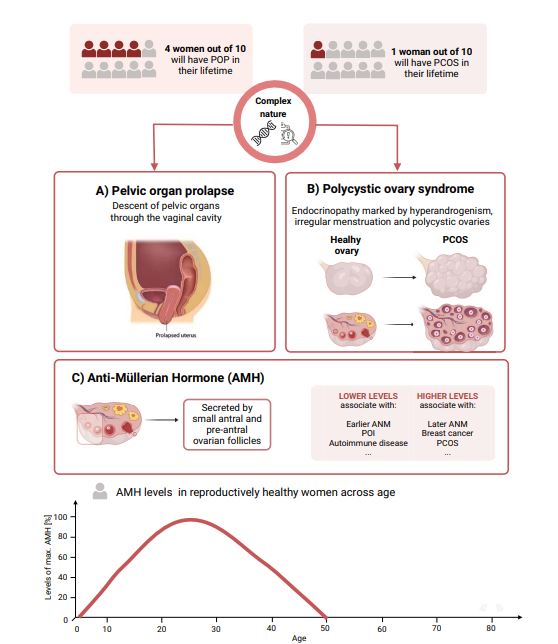Table of Contents
In a notable contribution to the field of women’s health, Natàlia Pujol Gualdo‘s doctoral thesis from the University of Tartu and the University of Oulu advances the understanding of genetic factors influencing female reproductive health. Her research, titled “Decoding genetic associations of female reproductive health traits”, explores the genetic landscape underlying conditions such as pelvic organ prolapse (POP), polycystic ovary syndrome (PCOS), and anti-Müllerian hormone (AMH) levels. This work provides insight into the biology of these traits and investigates the potential application of genetics in enhancing personalised medicine for women’s reproductive health.
Deciphering the genetic basis of Pelvic Organ Prolapse (POP)
Pelvic Organ Prolapse (POP) affects nearly 40% of postmenopausal women, where the pelvic organs descend into the vaginal cavity. Despite its prevalence, the genetic underpinnings of POP have remained largely unexplored. Natàlia Pujol Gualdo’s thesis research utilises genome-wide association studies (GWAS) to identify novel genetic risk factors for POP. The study reveals genetic variants and genes associated with connective tissue abnormalities, urogenital development, and cardiometabolic health, revealing a genetic link to other conditions like inguinal hernia and gastro-esophageal reflux.
This research also evaluated the predictive power of a score summarising the genetic risk for prolapse, incorporating additional risk factors such as body mass index, smoking, childbirth, constipation, and asthma. Although the predictive accuracy for clinical use was insufficient, the genetic risk significantly enhanced predictive power alongside other risk factors, potentially enhancing personalised preventive strategies. This work shed light on the affected biology underlying POP, offering new perspectives for preventive strategies.

Insights into Polycystic Ovary Syndrome (PCOS)
Polycystic Ovary Syndrome (PCOS) is a common endocrine disorder affecting women of reproductive age, characterised by symptoms such as menstrual irregularities, high androgen levels, and metabolic issues. Through this thesis, Pujol-Gualdo and colleagues identified an association between CHEK2 and PCOS, identifying rare genetic variants more prevalent in Estonian and Finnish populations. CHEK2, which encodes a protein crucial for cellular quality control and DNA repair in ovarian follicles, has been shown to be associated with women with PCOS, which also tends to show later age at menopause and an increased number of follicles.
The study emphasises the need for further research on the role of CHEK2 in PCOS and highlights the importance of population-specific biobank initiatives in understanding complex conditions such as PCOS.
Exploring the genetic background of Anti-Müllerian Hormone (AMH) levels
Anti-Müllerian hormone (AMH) serves as a proxy biomarker of ovarian reserve in women. This research thesis included the largest investigation on the genetic factors that influence AMH levels in pre-menopausal women through a combination of different cohorts with genetic and hormone measurements through GWAS meta-analyses.
Combining data from Northern Finland Birth Cohort 1966 and other European cohorts, this research identified several genetic loci affecting AMH levels, including CHEK2, providing valuable insights for better understanding factors influencing ovarian reserve. This work also aided the characterisation of GWAS signals enrichment in different biological pathways, reflecting a connection between urinary and reproductive system development, originating from a common embryological origin.
The value of genetic and genomics research for female reproductive health
Genetics and genomics are key tools in scientific research, especially for understanding female reproductive health, a field that has been largely understudied so far. Despite the slow progress in understanding the causes of these health conditions, the technology for analysing our genomes has advanced quickly and become more accessible. Population-specific data, combined with cutting-edge genomic techniques and electronic health records, position Estonia and Estonian Genome Centre as valuable places and resources to advance our understanding of biology underlying female reproductive conditions.
This research, placed at the intersection of genomics and female reproductive health, addresses a knowledge gap in national and international research systems by facilitating the discovery and characterisation of several genetic variants, genes and biological mechanisms underlying female reproductive health.
Natàlia Pujol Gualdo’s doctoral thesis can be found HERE.
If the wonders of medical science intrigue you and breakthroughs in healthcare excite you, delve deeper into more medical marvels on our webpage and read about how Cutting-Edge imaging unravels sex-specific structural variations in the heart!
 Back
Back



